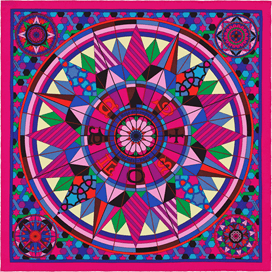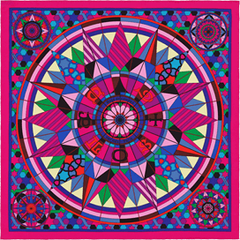Rose de Compas
Designed by Natsuno Hidaka
First edition in 2015
Login or Register to get extra informations (rarity, sku, original prices ...)
Hermes vintage silk scarf, hand rolled, 28" x 28"
The compass is a maritime navigational instrument, decorated with a windrose motif: the poetic-sounding name refers to a star design indicating the four cardinal points, and the multiple intermediary directions. A windrose may represent up to 32 points or ‘winds’ in this way. The Phoenicians were the first to use the windrose or compass rose, and it is sometimes said that the design’s bright, varied colours helped illiterate sailors to ‘read’ them. At the centre of his star, designer Natsuno Hidaka has reproduced the initial letters of the winds as they were named in Italy, in the Middle Ages. The graphic motif first appeared in a work published in Hamburg, in the early 20th century: A. Schück’s Der Kompass. The north wind (the Tramontana) is not represented, but a Maltese cross, representing the Holy City of Jerusalem, indicates the east wind, known as the Levante. Moving clockwise, we see the Sirocco (south-east), the Ostro (south), the Libeccio (south-west), the Ponente (west), the Maestrale (north-west) and the Grecale (north-east).
The compass is a maritime navigational instrument, decorated with a windrose motif: the poetic-sounding name refers to a star design indicating the four cardinal points, and the multiple intermediary directions. A windrose may represent up to 32 points or ‘winds’ in this way. The Phoenicians were the first to use the windrose or compass rose, and it is sometimes said that the design’s bright, varied colours helped illiterate sailors to ‘read’ them. At the centre of his star, designer Natsuno Hidaka has reproduced the initial letters of the winds as they were named in Italy, in the Middle Ages. The graphic motif first appeared in a work published in Hamburg, in the early 20th century: A. Schück’s Der Kompass. The north wind (the Tramontana) is not represented, but a Maltese cross, representing the Holy City of Jerusalem, indicates the east wind, known as the Levante. Moving clockwise, we see the Sirocco (south-east), the Ostro (south), the Libeccio (south-west), the Ponente (west), the Maestrale (north-west) and the Grecale (north-east).
Help us enhance Scarf Sage Hermès scarf collection by contributing additional information or higher quality images.

